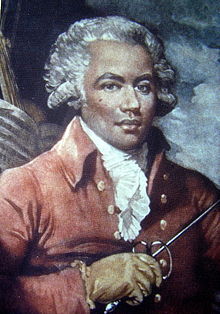The Celebrated Saint-Georges
A concert in Seattle got me intrigued about the life of Joseph Bologne, the Chevalier de Saint-Georges.
He was born on Guadeloupe in 1745, son of a wealthy planter and his black slave. At around age seven, he traveled to France to go to school. His parents joined him in Paris a couple of years later, his father receiving a noble title.
At age thirteen, Joseph went to a school of military arts. By his late teens, he was known as one of the finest swordsmen in France. The king granted him the title of chevalier.
That would be impressive enough, but in his twenties Joseph Bologne de Saint-Georges became one of Paris’s most celebrated musicians, concertmaster of the Concert des Amateurs. He wrote an opera with Pierre Choderlos de Laclos, later author of Les Liaisons Dangereuses. He also crossed paths with Wolfgang Amadeus Mozart, though no music seems to have come of that.
Then the American War started to affect Saint-Georges’s life. Because his orchestra’s patrons had put all their money into supplying the French army in America, the Concert des Amateurs had to shut down in 1781. He bounced back with a new patron in Philippe D’Orléans, duc de Chartres, and his lodge of Freemasons. With their support, Saint-Georges commissioned the Paris symphonies from Joseph Haydn.
In 1785, Philippe succeeded to his father’s title as duc d’Orléans. A cousin of King Louis XVI, the duke favored a constitutional monarchy along British lines, particularly if he could be in charge as regent. He sent Saint-Georges to London to strengthen contacts with the Prince of Wales, early anti-slavery activists, and other potential allies.
The portrait above comes from Saint-Georges’s time in London. It was painted by Boston-born Loyalist Mather Brown at the request of the Prince of Wales.
Saint-Georges was in the audience at the opening of the Estates General of France in 1789. That limited attempt at political change soon brought on the larger French Revolution. At first Saint-Georges continued work as a musician and courtier, but in 1792 he accepted a commission as colonel of a cavalry legion of free men of color from Haiti.
For the next several years, Saint-Georges was part of the army of Revolutionary France, caught up in its politics. That meant he spent some of his time at the front, some in Paris, some in jail. There’s evidence he went to Haiti in 1796 as part of the central government’s unsuccessful campaign to suppress Toussaint Louverture. Finally he returned to music, frustrated by government service and suffering from illness. Saint-Georges died in Paris in 1799.
TOMORROW: Another picture of Saint-Georges.
He was born on Guadeloupe in 1745, son of a wealthy planter and his black slave. At around age seven, he traveled to France to go to school. His parents joined him in Paris a couple of years later, his father receiving a noble title.
At age thirteen, Joseph went to a school of military arts. By his late teens, he was known as one of the finest swordsmen in France. The king granted him the title of chevalier.
That would be impressive enough, but in his twenties Joseph Bologne de Saint-Georges became one of Paris’s most celebrated musicians, concertmaster of the Concert des Amateurs. He wrote an opera with Pierre Choderlos de Laclos, later author of Les Liaisons Dangereuses. He also crossed paths with Wolfgang Amadeus Mozart, though no music seems to have come of that.
Then the American War started to affect Saint-Georges’s life. Because his orchestra’s patrons had put all their money into supplying the French army in America, the Concert des Amateurs had to shut down in 1781. He bounced back with a new patron in Philippe D’Orléans, duc de Chartres, and his lodge of Freemasons. With their support, Saint-Georges commissioned the Paris symphonies from Joseph Haydn.
In 1785, Philippe succeeded to his father’s title as duc d’Orléans. A cousin of King Louis XVI, the duke favored a constitutional monarchy along British lines, particularly if he could be in charge as regent. He sent Saint-Georges to London to strengthen contacts with the Prince of Wales, early anti-slavery activists, and other potential allies.
The portrait above comes from Saint-Georges’s time in London. It was painted by Boston-born Loyalist Mather Brown at the request of the Prince of Wales.
Saint-Georges was in the audience at the opening of the Estates General of France in 1789. That limited attempt at political change soon brought on the larger French Revolution. At first Saint-Georges continued work as a musician and courtier, but in 1792 he accepted a commission as colonel of a cavalry legion of free men of color from Haiti.
For the next several years, Saint-Georges was part of the army of Revolutionary France, caught up in its politics. That meant he spent some of his time at the front, some in Paris, some in jail. There’s evidence he went to Haiti in 1796 as part of the central government’s unsuccessful campaign to suppress Toussaint Louverture. Finally he returned to music, frustrated by government service and suffering from illness. Saint-Georges died in Paris in 1799.
TOMORROW: Another picture of Saint-Georges.


1 comment:
Magnificent!
Post a Comment